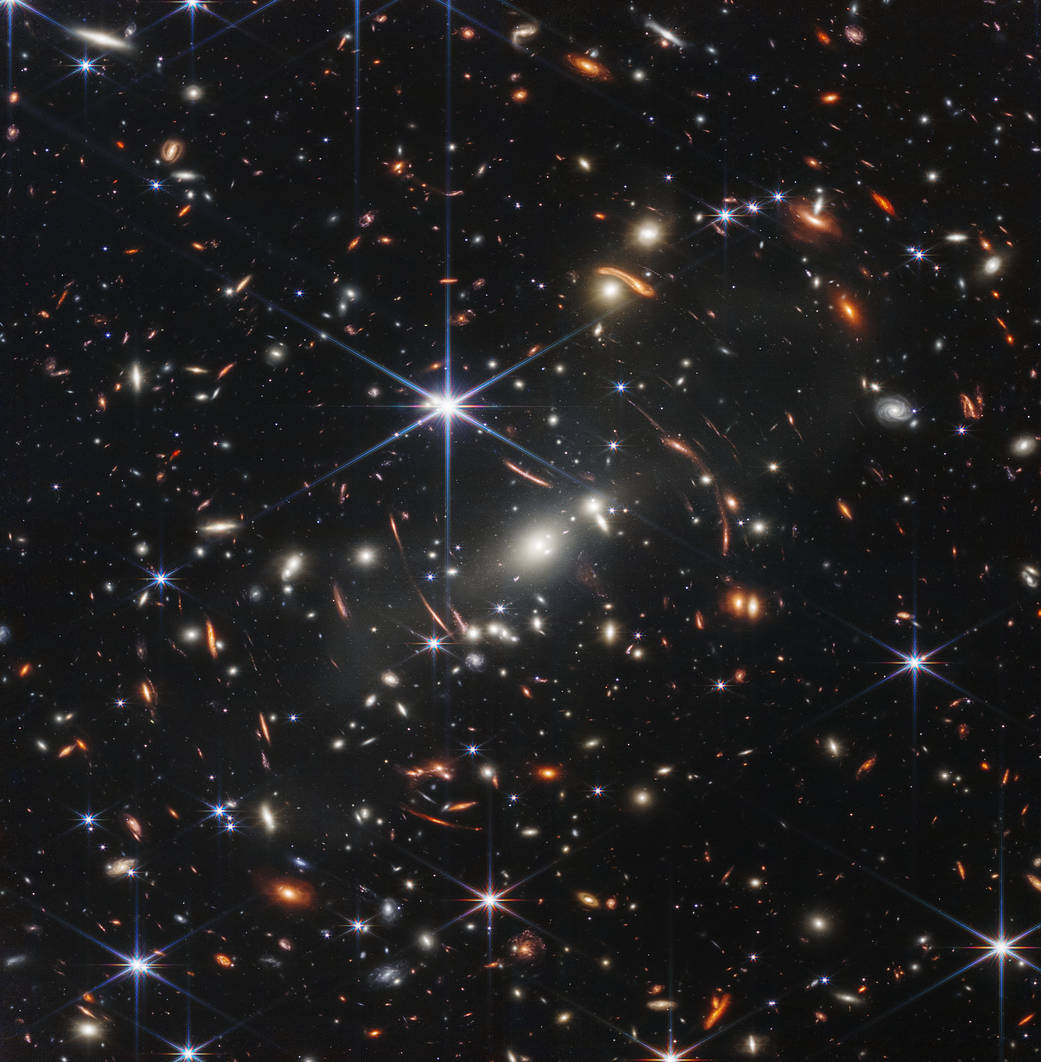
For SpaceUpClose.com & RocketSTEM
CAPE CANAVERAL, FL – President Joe Biden unveiled an absolutely stunning first full color science image captured by NASA’s massive new James Webb Space Telescope (JWST) that peers further and deeper back in time in the Universe than ever before and in the highest resolution ever achieved, and showing thousands and thousands of galaxies in unimaginable clarity in the faintest infrared light and dating from the first billion years.
The image known as ‘Webb’s First Deep Field’ showing just a tiny sliver of the Universe as it looked 13 Billion years ago was released by the President during a ceremony held at the White House Monday evening, July 11, with NASA Administrator Bill Nelson, Vice President Kamela Harris and the Webb team.
“If you held a grain of sand on the tip of your finger at arm’s length, that is the part of the universe that you’re seeing, just one little speck of the universe,” said Bill Nelson, NASA’s administrator, during the White House briefing with President Joe Biden and Vice President Harris.
“And what you’re seeing there are galaxies, you’re seeing galaxies that are shining around other galaxies whose light has been bent, and you’re seeing just a small little portion of the universe.”
“Webb’s First Deep Field is not only the first full-color image from the James Webb Space Telescope, it’s the deepest and sharpest infrared image of the distant universe, so far. This image covers a patch of sky approximately the size of a grain of sand held at arm’s length. It’s just a tiny sliver of the vast universe,” said Nelson.
This pushed up JWST release with the President was only announced late Sunday as part of a set of five total images.
“We’re looking back more than 13 billion years,” Nelson said. “Light travels 186,000 miles per second, and that light that you are seeing on one of those little specks has been traveling for over 13 billion years.”
Since the Universe is about 13.8 Billion years old, Webb is expected to look back even further over time to within about 200 million years of the Big Bang.
Biden beamed with pride as he unveiled the ‘Webb First Deep Field’ image.
President Joe Biden unveiled this new image of the galaxy cluster SMACS 0723 now known as Webb’s First Deep Field, during Monday’s White House event.
“These images are going to remind the world that America can do big things, and remind the American people – especially our children – that there’s nothing beyond our capacity,” said President Biden in remarks during the event.
“We can see possibilities no one has ever seen before. We can go places no one has ever gone before”
“As an international collaboration, this telescope embodies how America leads the world, not by the example of our power but by the power of our example.”
👀 Sneak a peek at the deepest & sharpest infrared image of the early universe ever taken — all in a day’s work for the Webb telescope. (Literally, capturing it took less than a day!) This is Webb’s first image released as we begin to #UnfoldTheUniverse: https://t.co/tlougFWg8B pic.twitter.com/Y7ebmQwT7j
— NASA Webb Telescope (@NASAWebb) July 11, 2022
The remaining four initial full color science and spectroscopic images will be released by NASA on Tuesday, July 12 during a NASA TV webcast starting at 9:45 a.m. and 10:30 a.m. ET.
“This mission was made possible by human ingenuity – the incredible NASA Webb team and our international partners at the European Space Agency and the Canadian Space Agency. Webb is just the start of what we can accomplish in the future when we work together for the benefit of humanity,” Nelson added.
This first slice of the vast universe from Webb covers a patch of sky approximately the size of a grain of sand held at arm’s length by someone on the ground.
If you held a grain of sand up to the sky at arm’s length, that tiny speck is the size of Webb’s view in this image. Imagine — galaxies galore within a grain, including light from galaxies that traveled billions of years to us!
— NASA Webb Telescope (@NASAWebb) July 11, 2022
This ‘Webb First Deep Field’ image was taken by the telescopes Near-Infrared Camera (NIRCam) over just 12.5 hours and is a composite of different wavelengths. By comparison it took NASA’s Hubbble Space Telescope (HST) many weeks to take its own stellar deep field images
“Thousands of galaxies – including the faintest objects ever observed in the infrared – have appeared in Webb’s view for the first time,” said NASA.
“This deep field, taken by Webb’s Near-Infrared Camera (NIRCam), is a composite made from images at different wavelengths, totaling 12.5 hours – achieving depths at infrared wavelengths beyond the Hubble Space Telescope’s deepest fields, which took weeks.”
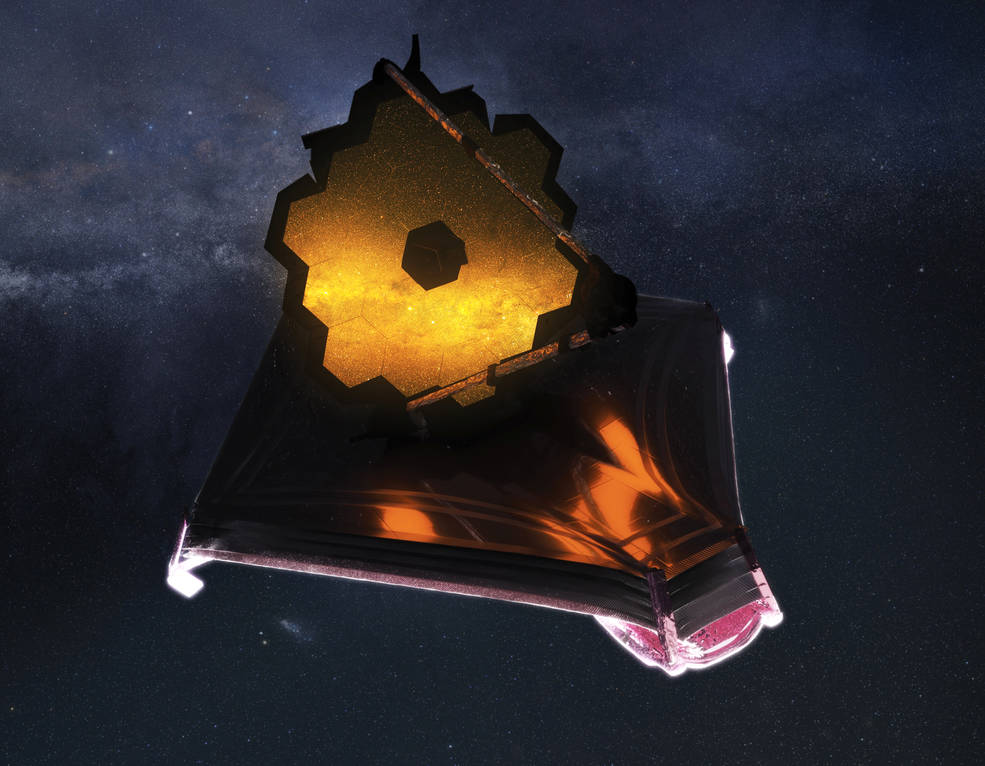
“Webb’s sharp near-infrared view brought out faint structures in extremely distant galaxies, offering the most detailed view of the early universe to date.”
Watch NASA TV on Tuesday morning, July 12, to see the release of the remaining images in the first suite of science images.
It's here–the deepest, sharpest infrared view of the universe to date: Webb's First Deep Field.
Previewed by @POTUS on July 11, it shows galaxies once invisible to us. The full set of @NASAWebb's first full-color images & data will be revealed July 12: https://t.co/63zxpNDi4I pic.twitter.com/zAr7YoFZ8C
— NASA (@NASA) July 11, 2022
Released one by one, the first images from the world’s largest and most powerful space telescope will demonstrate Webb at its full power, ready to begin its mission to unfold the infrared universe.
Following Monday’s release by President Biden the remainder will be released in NASA’s live broadcast beginning at 10:30 a.m. EDT Tuesday, July 12.
“Each image will simultaneously be made available on social media as well as on the agency’s website,” said NASA.
🗓️ Mark your calendars for Tuesday, July 12 at 10:30am ET (14:30 UTC) as we release the first images from @NASAWebb.
Join an event, virtually or in your community, and celebrate with us as we #UnfoldTheUniverse: https://t.co/ix80dN3PHe pic.twitter.com/RhiMRk25mm
— NASA (@NASA) July 1, 2022
Below is the remaining NASA list of cosmic objects that Webb targeted for these first observations.
“These listed targets below represent the first wave of full-color scientific images and spectra the observatory has gathered, and the official beginning of Webb’s general science operations. They were selected by an international committee of representatives from NASA, ESA, CSA, and the Space Telescope Science Institute.”
- Carina Nebula: The Carina Nebula is one of the largest and brightest nebulae in the sky, located approximately 7,600 light-years away in the southern constellation Carina. Nebulae are stellar nurseries where stars form. The Carina Nebula is home to many massive stars, several times larger than the Sun.
- WASP-96 b (spectrum): WASP-96 b is a giant planet outside our solar system, composed mainly of gas. The planet, located nearly 1,150 light-years from Earth, orbits its star every 3.4 days. It has about half the mass of Jupiter, and its discovery was announced in 2014.
- Southern Ring Nebula: The Southern Ring, or “Eight-Burst” nebula, is a planetary nebula – an expanding cloud of gas, surrounding a dying star. It is nearly half a light-year in diameter and is located approximately 2,000 light years away from Earth.
- Stephan’s Quintet: About 290 million light-years away, Stephan’s Quintet is located in the constellation Pegasus. It is notable for being the first compact galaxy group ever discovered in 1877. Four of the five galaxies within the quintet are locked in a cosmic dance of repeated close encounters.
The release of these first images marks the official beginning of Webb’s science operations, which will continue to explore the mission’s key science themes.
Webb is now expected to operate for as long as 20 years following an excellent launch and orbital arrival at the L-2 Lagrange Point with much less fuel expended than expected – although it was initially designed for a minimum 5-year operational lifetime.
“Scientists are thrilled that Webb is alive and as powerful as we hoped, far beyond Hubble, and that it survived all hazards to be our golden eye in the sky,” said John Mather, Webb senior project scientist at NASA’s Goddard Space Flight Center in Greenbelt, Maryland.
“What happened after the big bang? How did the expanding universe cool down and make black holes and galaxies and stars and planets and people? Astronomers see everything twice: first with pictures, and then with imagination and calculation. But there’s something out there that we’ve never imagined, and I will be as amazed as you are when we find it.”
Webb is a robotic mission and will function as a cosmic time machine peering back to nearly the beginning of time to see first light and explore the formation of the first stars and galaxies in our Universe in infrared light.
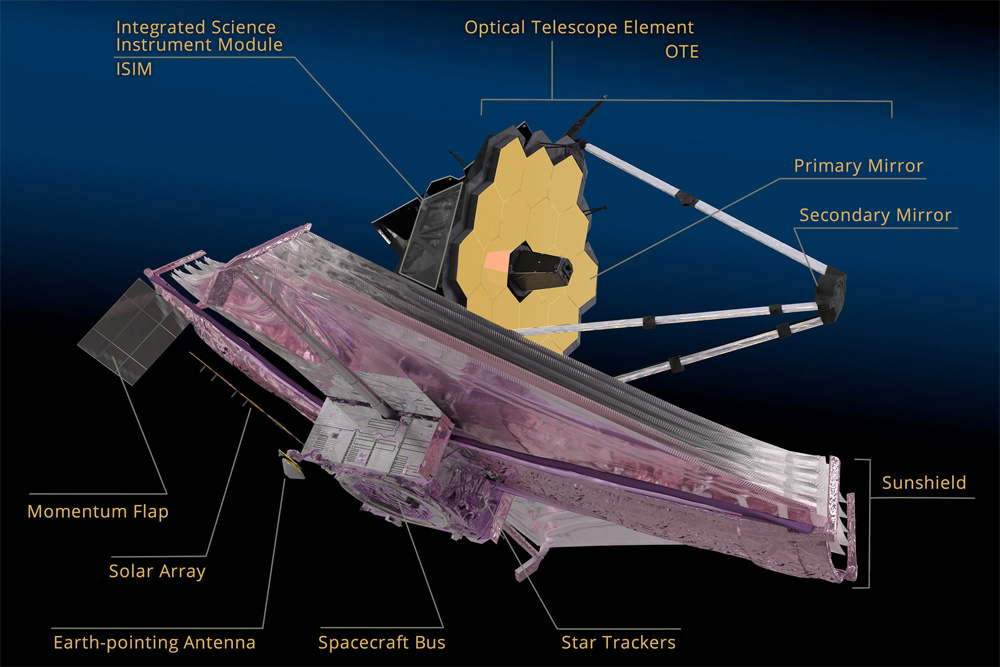
The giant school bus sized and nearly 6.8-ton (6.2-metric ton) infrared observatory has huge ambitions – despite being billions over budget and years behind schedule and faced down cancellation from short-sighted budget cutters in Congress.
It seeks to ask and answer the big questions – Who we are? How did we come to be? by looking back to the birth of the Universe
The $9.8 Billion Webb observatory – intricately folded up like origami inside the nose cone – launched at 7:20 a.m. EST (9:20 a.m. GFT / 1220 GMT / 13:20 CET). Saturday, Dec. 25, on a 55 m (180 ft) tall Arianespace Ariane 5 rocket from Europe’s jungle Spaceport at the ELA-3 launch complex in Kourou, French Guiana, on the northeastern coast of South America.
Webb is a joint effort between NASA, ESA (European Space Agency) and CSA (Canadian Space Agency).
JWST is the largest, most powerful and most complex space telescope ever built.
It is also the most expensive science instrument ever costing nearly $10 Billion
It will operate in a halo orbit at the L2 Lagrange point approx. 1 million miles (1.6 million km) from Earth after liftoff and about a 1-month journey.
It will serve as the scientific successor to NASA’s world famous and phenomenally successful Hubble Space Telescope (HST).
“The James Webb Space Telescope represents the ambition that NASA and our partners maintain to propel us forward into the future,” said NASA Administrator Bill Nelson.
“The promise of Webb is not what we know we will discover; it’s what we don’t yet understand or can’t yet fathom about our universe. I can’t wait to see what it uncovers!”
Webb is in many respects a time machine looking back to the formation of the Universe over 13.5 Billion years ago and how we came to be and evolve over the eons.
I observed JWST many times while under construction at NASA Goddard Spaceflight Center in Greenbelt, MD, to observe assembly of the primary and secondary mirrors onto the observatory backbone structure at various points
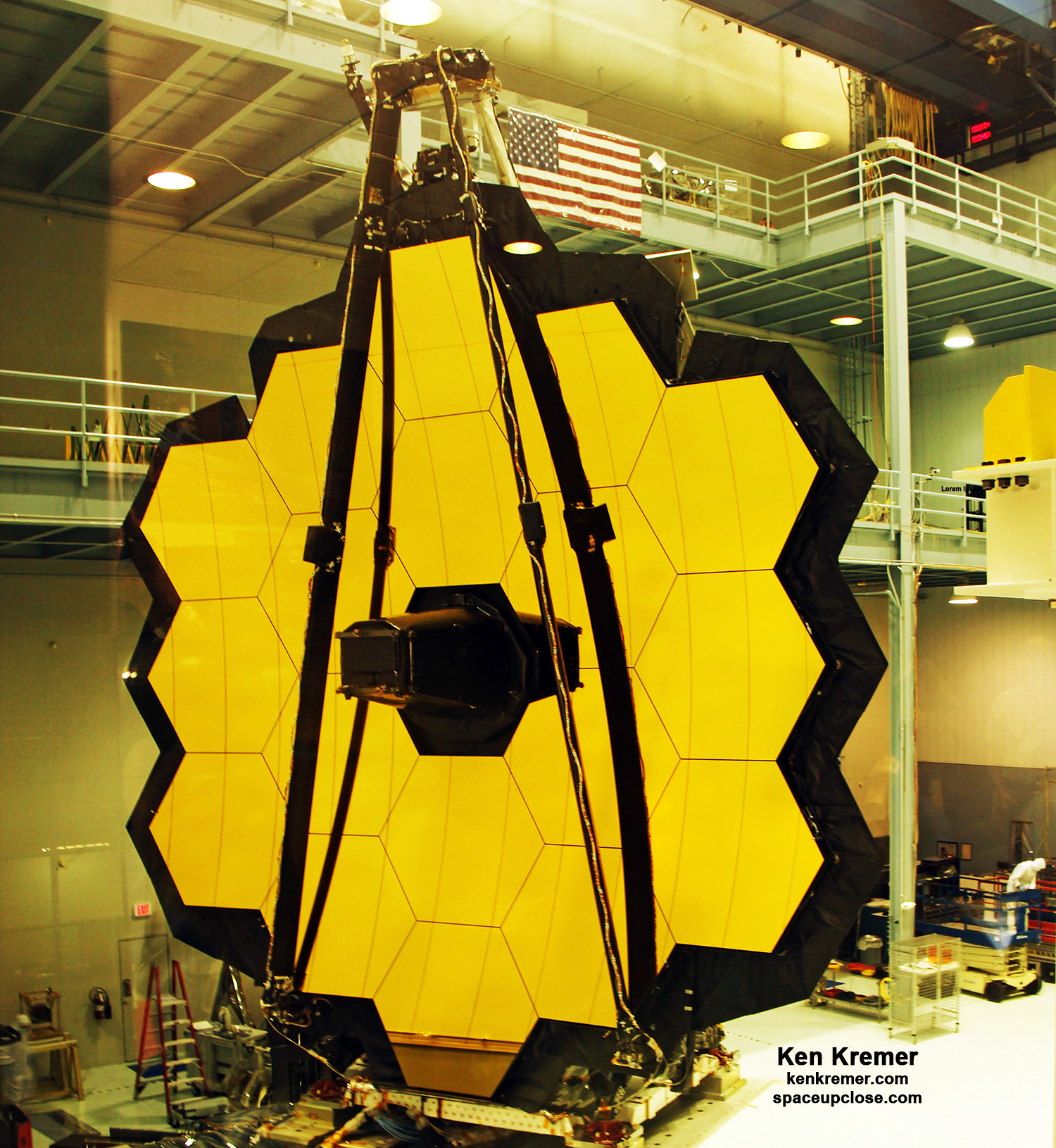
Watch Ken’s BBC World TV interview about Webb achieving final orbit and the goals ahead on Jan 24, 2022.
Video Caption: Dr. Ken Kremer of Space UpClose live interview on BBC World News TV on Jan. 24, 2022 ET (Jan. 25 GMT) about NASA James Webb Space Telescope (JWST) just hours after achieving orbit at its final destination, why at L2, what’s ahead with spacecraft checkouts, what are the science goals and when are first pictures expected
Watch Ken’s commentary about Project Artemis, Capstone, NASA SLS WDR demo test, SpaceX missions including NASA Crew-3 and Crew 4, AX-1, Nilesat 301, Transporter-5, Starlink, Boeing Starliner, and NASA TROPICS 1.
Jul 6/7: Fox 35 Orlando featured my commentary about NASA Capstone cubesat mission – communications just reestablished after 2 day loss. Capstone is a pathfinder mission for NASA’s Gateway mini lunar space station. Now preparing for 1st trajectory correction maneuver (TCM) and heading to lunar orbit
Jul 5/6: WKMG CBS 6 Orlando News featured my commentary about todays loss of contact with NASA’s CAPSTONE lunar cubesat mission. CAPSTONE had been healthy until a 2nd comm pass. Team is attempting to reestablish contact. Goal: test the stability of the unique orbit planned for NASA Gateway mini human space station:
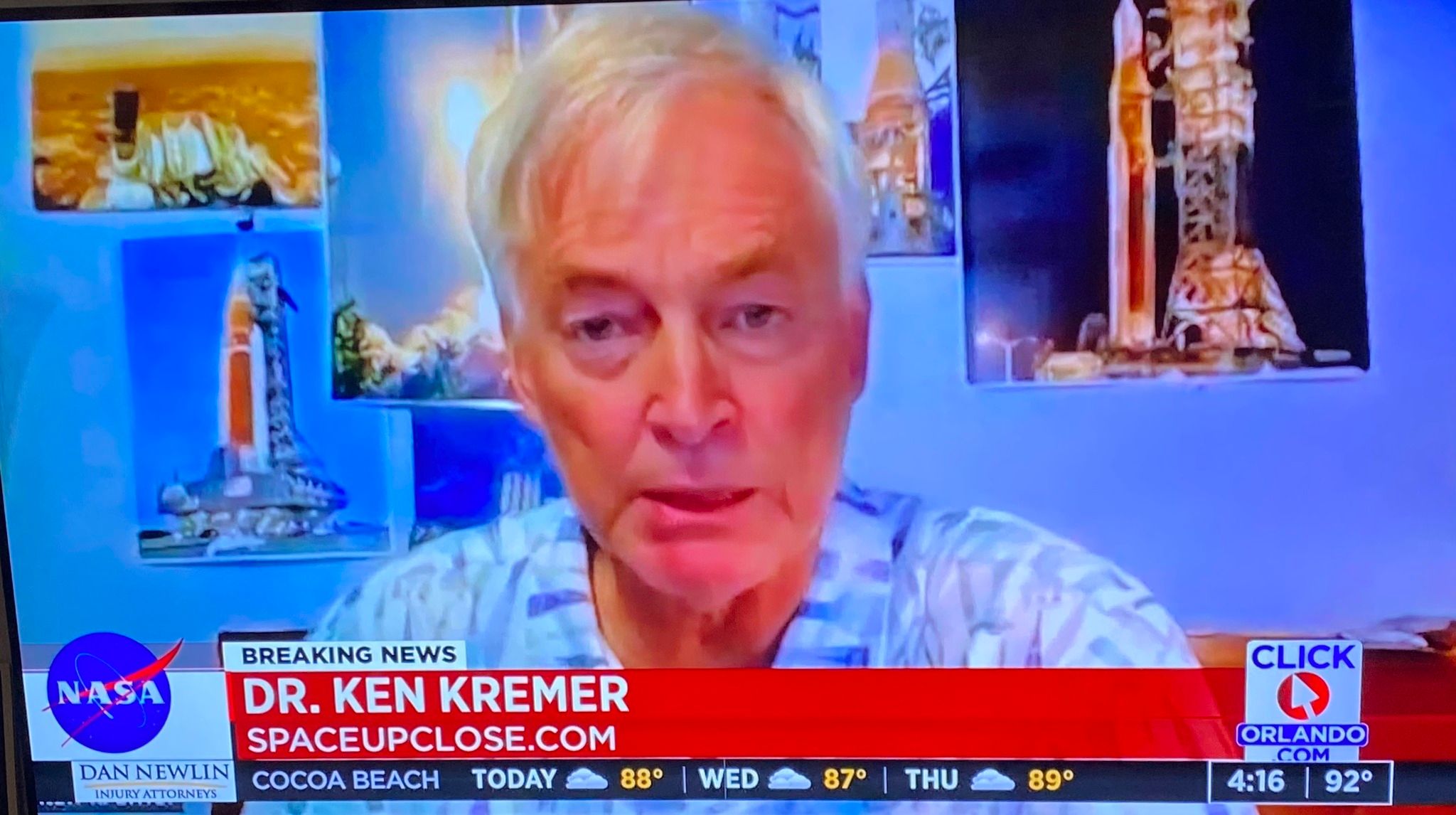
Jul 5/6: WFTV ABC Orlando News featured my commentary about today’s loss of contact with NASA Capstone cubesat mission which is a pathfinder test for the Gateway mini human lunar space station
Jun 21/22: WFTV ABC Orlando News featured my commentary about NASA’s 4th SLS WDR fueling attempt Jun 20, the results and whats ahead after NASA conducts detailed analysis of the 1st tanking test to completely load both stages with LOX & LH2 and run the terminal count to T-29 sec despite a hydrogen leak – achieving many but not all objectives
Jun 17: Fox 35 Orlando featured my commentary about the selection of 2 NASA astronauts to fly on the 1st crewed mission of Boeing Starliner capsule on CFT test flight late 2022 – and what it means for human spaceflight to have a 2nd US commercial crew provider following the successful Boeing Starliner OFT-2 mission for NASA
Jun 9/10: WFTV ABC Orlando features my commentary about the upcoming NASA TROPICS 1 & 2 cubesat science launch on an Astra Rocket 3.3 from pad 46 for NASA which will study the formation and evolution of Tropical Cyclones and Hurricanes. Two more launches will follow for 6 TROPICS cubesats altogether over next few months
Jun 8: WFTV ABC Orlando features my commentary about the SpaceX Falcon 9 launch of NileSat301 telecom sat for Egypt
June 6/7: WFTV ABC Orlando features my commentary about completing 2nd rollout to pad 39B for 2nd round WDR tanking test, what’s involved in and why its critical to the future of Project Artemis:
Watch Ken’s continuing reports about SpaceX missions Artemis, SLS, Orion and NASA missions, SpaceX Crew and Cargo Dragons, SpaceX Axiom-1, JWST, IXPE, DART, Lucy Asteroid mission, GOES, SpaceX Starlink, Commercial Crew and Starliner and Crew Dragon, Blue Origin and Space Tourism, and onsite for live reporting of upcoming and recent SpaceX and ULA launches including Crew 1 & 2 & 3 & 4, ISS, Solar Orbiter, Mars 2020 Perseverance and Curiosity rovers, NRO spysats and national security missions and more at the Kennedy Space Center and Cape Canaveral Space Force Station.
Stay tuned here for Ken’s continuing Earth and Planetary science and human spaceflight news: www.kenkremer.com –www.spaceupclose.com – twitter @ken_kremer – email: ken at kenkremer.com
Dr. Kremer is a research scientist and journalist based in the KSC area, active in outreach and interviewed regularly on TV and radio about space topics.
………….
Ken’s photos are for sale and he is available for lectures and outreach events
Please consider supporting Ken’s work by purchasing his photos and/or donating at Patreon
https://www.patreon.com/kenkremer
x



